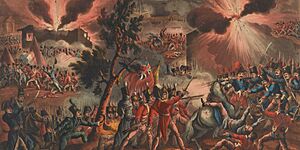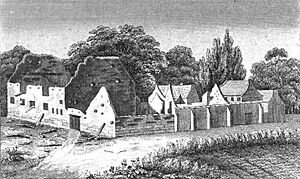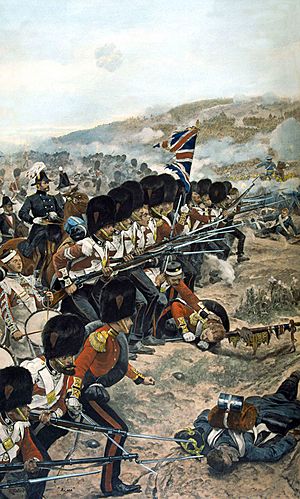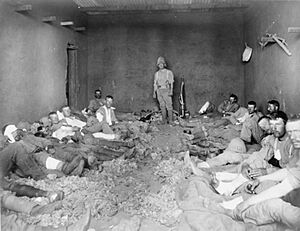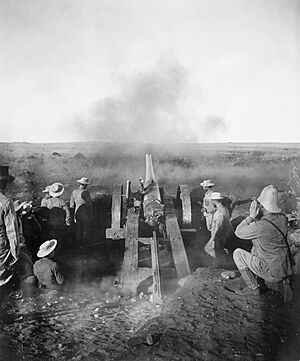History of the British 1st Division (1809–1909) facts for kids
Quick facts for kids
|
|
|---|---|

Paul Methuen, who led the division during the Second Boer War
|
|
| Active | 1809 – present |
| Country | |
| Branch | |
| Nickname(s) |
|
| Anniversaries | Peninsular Day |
| Engagements | |
The 1st Division is a famous part of the British Army. It's an infantry division that has been created and ended many times since 1809. Today, it is still active as the 1st (United Kingdom) Division.
Lieutenant-General Arthur Wellesley (who later became the Duke of Wellington) first formed this division in 1809. This was for the Peninsular War, which was part of the bigger Napoleonic Wars. The division was stopped in 1814 but started again the next year. It then fought bravely at the Battle of Waterloo, where it stopped many attacks by the French. After this battle, the division marched into France. It was later disbanded a few years later.
In the mid-to-late 1800s, other groups called the 1st Division were formed. The current division says three of these are part of its history. One was formed in 1854 in Bulgaria. It fought in the Crimean War, including the Battle of Inkerman and the Siege of Sevastopol. It was disbanded after the war. Another division was formed in Africa in 1879 for the Anglo-Zulu War. It didn't have a big impact and was also disbanded. The last division with this name was created in 1899 when the Second Boer War began. This division was formed in England and sailed to southern Africa. It fought in many major battles to help the city of Kimberley. These battles had many casualties. A defeat at the Battle of Magersfontein was a very difficult moment for the British. The division had more success in 1900. It was eventually disbanded as the British Army changed how it fought.
Unlike earlier divisions that were only for specific wars, a new, permanent 1st Division was formed in 1902 in the UK. It fought in the First and Second World Wars. In the 1970s, it became the 1st Armoured Division. It fought in the Gulf War. In 2014, it was renamed the 1st (United Kingdom) Division.
Contents
Napoleonic Wars: Fighting for Freedom
Peninsular War: Birth of a Division
Before the Napoleonic Wars, the British Army mostly used smaller groups called brigades. These were two or more battalions led by a major-general. As the army grew, it started using larger groups called divisions. A division was a single group of two or more brigades, usually led by a lieutenant-general. Other European armies had already used this idea.
On 18 June 1809, Lieutenant-General Arthur Wellesley (later the Duke of Wellington) was leading British forces in Spain and Portugal. He reorganized his army into four divisions. The 1st Division was one of them.
When it was formed, the 1st Division had guardsmen and other British and German soldiers. Because of the guardsmen, it was seen as a high-class group and was nicknamed "The Gentlemen's Sons". This division of almost 6,000 men first fought at the Battle of Talavera in July 1809. They were a key part of the army. On 28 July, they faced two French divisions with 15,000 men. The British and German soldiers were told to wait until the French were very close. Then they fired a single, powerful volley. This caused huge losses for the French. The 1st Division then charged forward. But they ran into a second French line and had to fight their way back. Other British forces helped them hold the line. By the end of the battle, the 1st Division had lost 2,249 soldiers.
The division fought again at the Battle of Bussaco in September 1810, losing 141 men. Then came a retreat to the Lines of Torres Vedras. In 1811, they lost 828 men at the Battle of Fuentes de Oñoro. In 1812, the division helped in the Siege of Ciudad Rodrigo. On 22 July, they fought at the Battle of Salamanca, defending the village of Arapiles. This battle cost them 158 men. In September 1812, the division surrounded Burgos castle. They fought off French attacks and tried to storm the castle twice, but failed. They lost nearly 2,000 men in this unsuccessful siege.
In May 1813, a new campaign began. The 1st Division fought in several battles that month: San Millan-Osma, Vittoria, and Tolosa. They were also at the start of the Siege of San Sebastián in July. In August, about 400 volunteers from the division helped storm San Sebastián. Nearly half of them became casualties.
The invasion of France followed. The division fought at the Battle of the Bidassoa in October. They crossed the Bidasoa River, pushed back the French, and took the village of Béhobie. This cost them about 160 men. Battles at the Battle of Nivelle in November and the Battle of the Nive in December caused more casualties. After a short rest, the division crossed the Adour river in February 1814. Napoleon gave up his power after the 1814 capture of Paris on 31 March. The 1st Division was besieging Bayonne. On 14 April, the French attacked from Bayonne. The division fought in the last battle of the War of the Sixth Coalition, losing over 700 men. With the war over, the division was broken up. Soldiers either went back to the UK or to North America for the War of 1812.
Waterloo Campaign: A Decisive Victory
After the fighting, British and Hanoverian troops moved into the Southern Netherlands. This was to secure the area while waiting for peace talks. On 11 April 1815, Napoleon returned to power, starting the War of the Seventh Coalition. Allied forces arrived, and the army was reorganized. The 1st Division was reformed under Major-General George Cooke. It had four foot-guard battalions, including one that had served in the Peninsular War. This division was the only one in Wellington's new army made entirely of British infantry.
The 1st Division's first fight in this new war was at the Battle of Quatre Bras on 16 June 1815. They arrived late in the day and launched a counterattack to retake Bossu Wood. They drove out the French but were pushed back by a second French line. Fighting continued, and they also stopped a French cavalry attack. They lost 46 killed and 508 wounded.
Two days later, at the Battle of Waterloo, the division was on the right side of the Allied army's front line. Their four battalions were hidden behind a ridge. Their light infantry companies, along with Hanoverian and Nassau troops, took an advanced position at Hougomont. This was a walled farm complex in a wooded area in front of the ridge. The farmhouse became a very important place to hold.
In the late morning, Napoleon ordered the farm to be captured. This started the battle. As French troops moved forward, the 1st Division's guns fired, stopping several attacks. But the French pushed into the woods and forced the division's infantry back into the farm. A French officer used an axe to break the gates, letting many French soldiers into the courtyard. In the fierce hand-to-hand fight, the gates were closed, trapping the French inside. All of them were killed. Lieutenant-Colonel James Macdonell and Corporal James Graham were noted for their bravery.
Fighting continued around the farm. French troops tried to surround Hougomont and attack from behind. The division's guns and fresh infantry stopped these moves. An attempt to climb the northern wall and open the gate from inside was also stopped. French artillery fired all day, damaging the walls and setting buildings on fire. A new attack in the late afternoon was also driven off. The final main French attack of the day, in the evening, pushed past Hougomont towards the Allied ridge. After the French units were defeated, the Allied army advanced and reinforced Hougomont.
Maitland's brigade, on the crest of the ridge, was under heavy French cannon fire all day. They stopped several cavalry and infantry attacks. Around 7:00 PM, the Middle Guard of the Imperial Guard launched the final French attack. Maitland's brigade formed a four-ranks-deep line and lay down. The French attack came in waves. The 3rd and 4th Régiment de Chasseurs led the way. Wellington then reportedly shouted, "Up, Guards, make ready!". The sudden appearance of the brigade made the French stop. Maitland's battalions heavily attacked the 4th Chasseurs and forced them to retreat. The British Guards followed with a bayonet charge. This made the 3rd Chasseurs also retreat. The next wave was led by the 3rd Régiment de Grenadiers. Maitland's troops stopped their chase and reformed. Both sides exchanged fierce volleys. While the French focused on Maitland's men, the British 2nd Division attacked from the side. They fired close-range volleys and charged, making the French retreat.
During the battle, the 1st Division lost 232 killed and 819 wounded. The next day, the division marched into France and reached Paris on 1 July. The French surrendered soon after, ending the war. The 1st Division stayed in France as part of the Army of Occupation until December 1818. It was disbanded when the British military left France.
Victorian Era: New Challenges
The 1st Division's history includes the Peninsular War, the Battle of Waterloo, the Crimean War, the Anglo-Zulu War, and the Second Boer War. Other 1st Divisions were formed during the 1800s for specific needs. For example, one was raised in 1851 for the Eighth Xhosa War. Another was part of an expedition to China in 1857 for the Second Opium War.
Crimean War: Fighting in the East
On 28 March 1854, Britain and France declared war on Russia to support the Ottoman Empire. British and French forces landed in Turkey and then moved to Varna, Bulgaria. There, they were reorganized into divisions. Prince George, Duke of Cambridge was chosen to lead the 1st Division. He was Queen Victoria's cousin.
On 14 September, the British and French landed north of Sevastopol in Crimea. They marched south and met the Russians at the Alma River. On 20 September, the 1st Division fought in the Battle of the Alma. They crossed the river, attacked, and cleared a Russian fort on Kourgané Hill. They lost 439 men. The army then surrounded the Russian port in October, starting the Siege of Sevastopol.
In October, at the Battle of Balaclava, the 1st Division moved to help British forces because many Russian troops were gathering. The division did not directly fight the Russians. The famous Charge of the Light Brigade happened during this battle.
On 5 November, the Russian Army launched a big attack called the Battle of Inkerman. The 1st Division, with three battalions, moved to help the 2nd Division, which was in trouble. In a heavy mist, they fought the Russians up close with bayonets. Throughout the morning, 582 men of the division were killed, wounded, or missing. The Duke of Cambridge's horse was shot, and he left the battle. The Allies won, but the battle made the siege last longer through the winter. In 1855, the 1st Division mostly played a supporting role in the siege. The army stayed in Crimea until the war ended in 1856.
Second Boer War: A Tough Campaign
The Second Boer War began on 11 October 1899. Tensions grew between the British Empire and the Boer republics. Britain sent a large force, including the 1st Division, to southern Africa. Lieutenant-General Paul Methuen led the 1st Division. Most of the division left the UK in late October and arrived in Cape Town about three weeks later.
Before they arrived, the Boers invaded British colonies and surrounded Kimberley and Ladysmith. The plan changed. Most of the arriving force went to help Ladysmith. The 1st Division was sent to help Kimberley. It had about 7,726 infantry and 850 cavalry.
The advance towards Kimberley began on 21 November. The 1st Division met the Boers near Belmont. The Boers had dug in on hills. At the Battle of Belmont on 23 November, the division attacked and captured these positions. But most Boers got away in good order. British losses were 54 killed and 243 wounded. The battle was a victory, but not a decisive one, because the division couldn't chase the retreating Boers.
Similar battles happened on 25 and 28 November at Graspan and Modder River. They lost 628 men in these two battles. After the Battle of Modder River, the Boers destroyed a railway bridge and retreated to Magersfontein. The 1st Division rested and waited for reinforcements. On 11 December, the Battle of Magersfontein took place. Despite artillery fire, the 1st Division's attack failed, with 948 casualties. This defeat, along with others that week, led to a difficult time for the British.
After Magersfontein, Methuen retreated to the "Modder position". There were talks about replacing Methuen, but he stayed in command. From this position, the division carried out patrols and raids into the Orange Free State. They destroyed farms and seized animals. In January, the 1st Division took on a defensive role. Many of its troops were moved to other commands. The division received large siege guns to help its defense. Its presence stopped the Boers from trying to invade Cape Colony.
Behind the 1st Division, four more divisions were gathered. On 7 February, a new attack began. It lifted the siege of Kimberley on 15 February. The 1st Division helped protect the flanks and supply lines. Two days later, the division moved to Kimberley. It guarded British supply bases and helped clear the area of Boer forces. It also supported efforts to lift the Siege of Mafeking.
In March, the 1st Division advanced, taking several villages and reaching Warrenton. They also repaired bridges and railway lines. On 5 April, a small Boer group was defeated at the Battle of Boshof. The division continued to advance and patrol. It marched east towards Kroonstad, covering 168 miles in 15 days. They captured small Boer forces and destroyed ammunition. The 1st Division arrived at Kroonstad on 28 May and was nicknamed the "Mobile Marvels".
In June, the division tried to trap the Boer leader Christiaan de Wet. They stormed Boer positions near Lindley but were too late to help some besieged British troops. From 17 to 23 June, the British Army changed its strategy to fight the Boers' guerrilla warfare tactics. Methuen's command became a "flying column" of 3,600 men. This group was more mobile and constantly searched for Boer forces. The rest of the division's troops were assigned to similar columns or to guard towns. The long chase of de Wet and other Boer leaders went on for months. By the end of 1900, the field divisions were gone. More mobile columns were formed as British strategy changed to fight the Boers.
Modern Era: A Permanent Force
After the Boer War, the British Army learned important lessons. The Secretary of State for War, St John Brodrick, wanted to improve the army. He planned to create six army corps, with three made of permanent, ready-to-deploy divisions. In 1902, three corps were formed, allowing up to nine divisions. The 1st Division was reformed on 30 September 1902. Major-General Arthur Paget took command. The reformed division had two brigades, each with four infantry battalions. The 1st Division, along with the 2nd and 5th, was considered ready for war.
In 1907, the Haldane Reforms further changed the regular army. It was reorganized into six infantry divisions, each with three brigades. These divisions would form the core of a British Expeditionary Force (BEF) to be sent to Europe if war broke out. The 1st Division was assigned a third brigade, along with engineers and artillery.
History Beyond 1909: World Wars and Beyond
The 1st Division went on to fight in the First (1914–1918) and the Second World Wars (1939–1945). In February 1945, it moved to Palestine. During the early Cold War years, the 1st Division was stationed in Palestine, Libya, and Egypt. It returned to the UK in 1955. It was disbanded on 30 June 1960 because there was no need for another division headquarters in the UK.
However, the very next day, it was reformed! The 5th Division was renamed and took on the 1st Division's history and badges. The new 1st Division was based in Germany as part of the British Army of the Rhine. In April 1978, it was renamed the 1st Armoured Division. Under this name, it fought in the Gulf War in 1990–1991.
When the Cold War ended, the British government reorganized the army. The 1st Division was disbanded again on 31 December 1992. But in 1993, the 4th Armoured Division in Germany was renamed the 1st (United Kingdom) Armoured Division. In the 1990s, the division was sent to Bosnia for peacekeeping during the Bosnian War. In the 2000s, it fought in the Iraq War. In 2014, the division was renamed the 1st (United Kingdom) Division.
See also
- List of commanders of the British 1st Division
- List of wartime orders of battle for the British 1st Division (1809–1945)
- List of Victoria Cross recipients from the British 1st Division


